Sometimes [the Lilliputians] determined to starve me; or at least to shoot me in the face with poisoned arrows, which would soon despatch me; but again they considered, that the stench of so large a carcass might produce a plague in the metropolis, and probably spread through the whole kingdom.
– from Gulliver’s Travels (1726) by Jonathan Swift
The first, most obvious, and most frequent observation made about Central Kentucky artist Steve Armstrong’s body of work is that it’s like a well-appointed 19th-century nursery room full of children’s toys. His sculpted wood automata, which move in countless, often delightfully surprising ways by means of simple yet ingenious mechanisms involving gears, turntables, levers, and cranks, would have been among any Victorian boy or girl’s prized possessions. Even today, when children who still believe in Santa Claus are writing him letters asking for the latest Xboxes and PlayStations, it’s hard to imagine any who wouldn’t recognize most of Armstrong’s pieces as the charming, irresistible treasures they are.
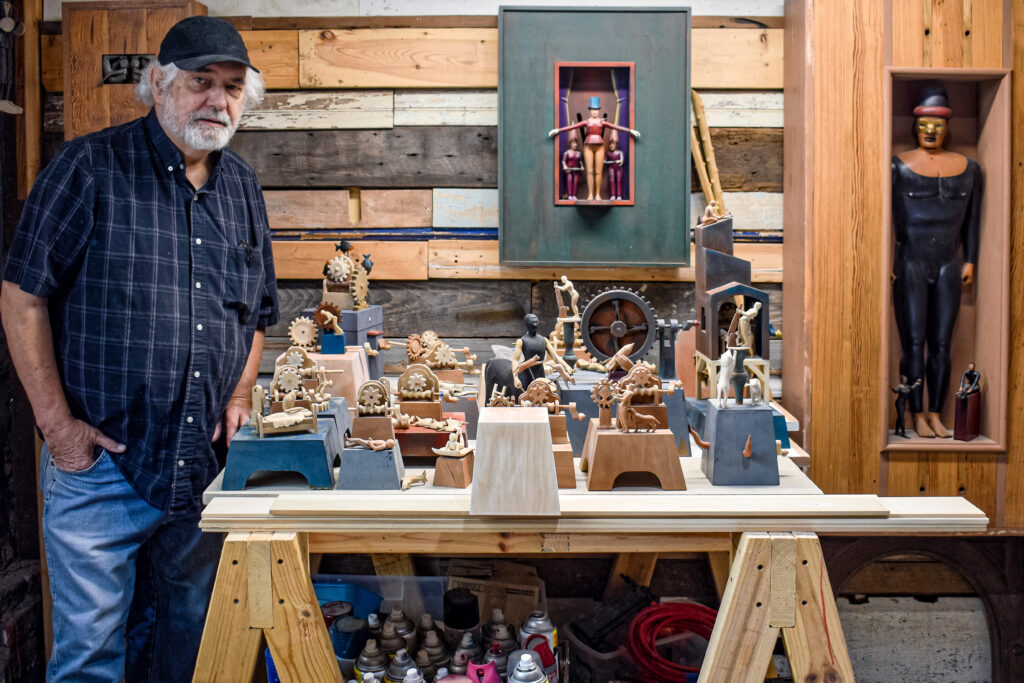
In “Last Train to Lilliput,” a new exhibit of Armstrong’s miniature automata at the Pam Miller Downtown Arts Center’s Black Box Theater, their toylike character is stronger than ever. (Armstrong once worked in a large studio at the University of Kentucky, where he often produced pieces of relatively large dimensions; since the onset of the coronavirus pandemic, he has worked in considerably smaller quarters at Lexington’s Luigart studio complex, resulting in these new, more compactly scaled pieces.) Turn the cranks and the mouths of various animals open and shut, as if roaring, snarling, or snapping. Musicians play, workers work, birds flap their wings. Cats run rampant, chasing dogs or emerging, like those sneaky Greek warriors at the siege of Troy, from inside a hollow sculpture, in this case, a great horned bull. A giant clamshell yawns, comically, at the bottom of the sea.
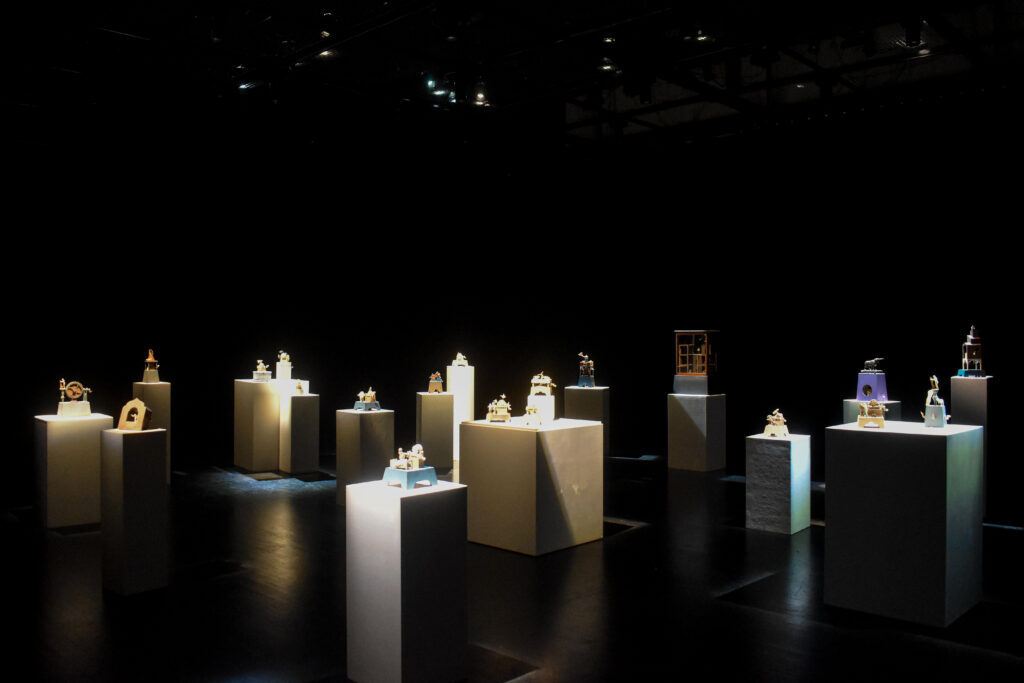
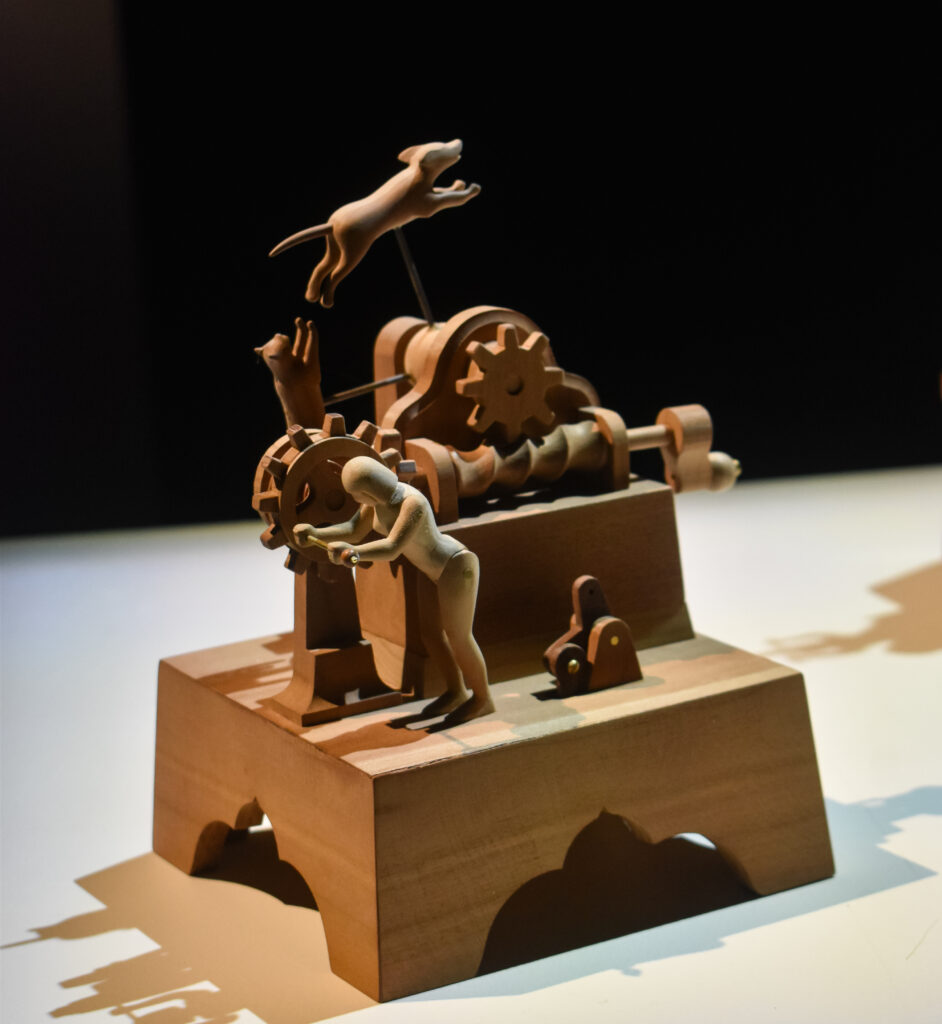
But while this common take on Armstrong’s work – implying as it does a certain naïveté, a certain innocence – is undeniably apt, it’s not the whole story. Nor is focusing on the movement of the pieces, in particular the mechanical systems with which those movements are triggered. Together they may unintentionally lead to a diminishment, even a trivializing of Armstrong’s work, in more ways than one.
The first of these ways overlooks Armstrong’s gifts as a sculptor. Although his carving of Kentucky hardwoods may well derive, at least in part, from traditional Appalachian whittling, it has far deeper roots, going back to antiquity. The high refinement of many of the humanoid and animal figures in this exquisite show – gleaming in the darkened theater in pools of light by the arts center’s terrific designer Tom Willis – depends neither on their movement nor their whimsical, nominally juvenile qualities. “I don’t care if it moves or not,” Armstrong said recently of the magnificent animal at the top of “Trojan Bull.” “I wanted it to be strong sculpturally, even if it didn’t move…I was thinking of these ancient pieces of art from Mycenae or someplace.” In that piece and several others here, Armstrong hits the bullseye. The onion dome orbited by a flying carpet in “Scheherazade” has the graceful exactitude of high-end architectural models. The eponymous sea creatures in “Piranhas,” “Mantas” and “Dolphins,” respectively, seem to have leapt straight out of a Jacques Cousteau documentary.
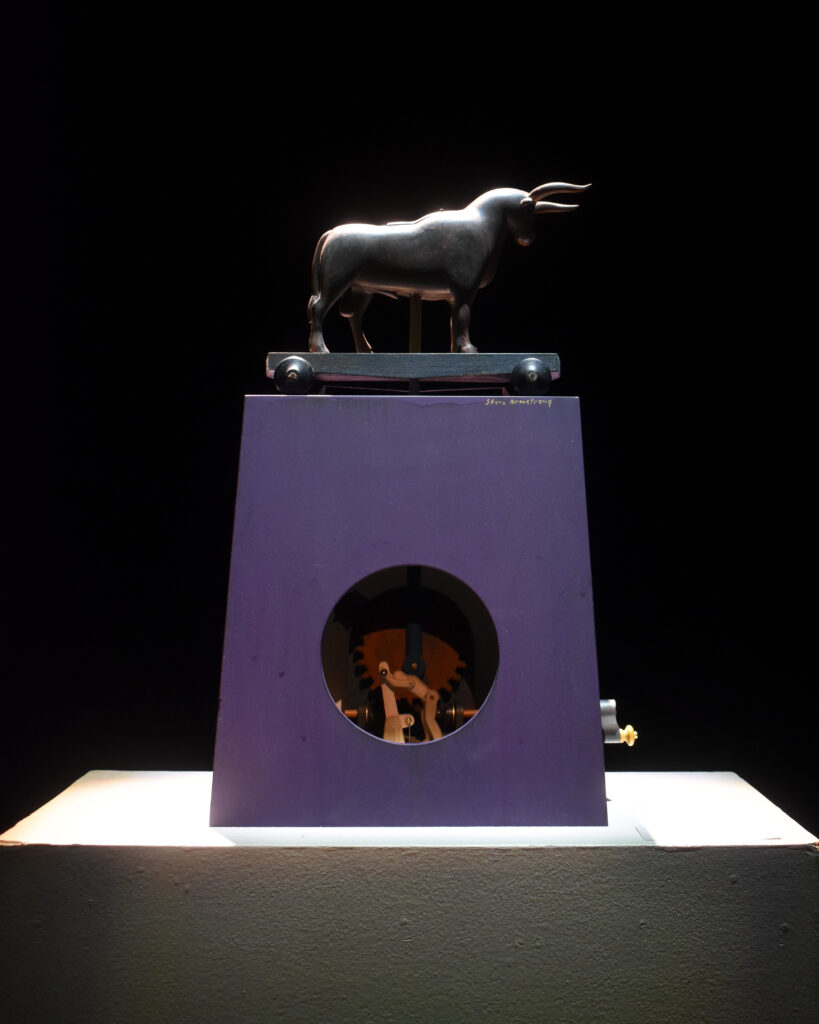
More important, to think of Armstrong’s work primarily in the context of children’s toys is to underestimate, if not entirely ignore, its often barely concealed darkness. (The popular American conception of childhood as a time of innocence, safety, and fun turns a blind eye to all sorts of harsh realities, but that’s a topic for a different essay.) If some of the narratives implicit in Armstrong’s pieces can feel like fairy tales, they are the more macabre stories of the Brothers Grimm, full of menace, violence, and intimations of mortality. In “Carnivore,” four hungry wolves surround a human hand, clearly preparing to tear it to shreds; carnage is likewise imminent in “Man Threatened by Lions.” If you take them seriously enough, “Heartbeat” and “The Nightmare” – the latter seemingly inspired by the creepy old folk tale about the cat who slips into your bedroom and parks on your chest, stealing your breath as you sleep – are as terrifying as anything dreamed up by Edgar Allan Poe. When that grinning clamshell (in “Blue Garden”) opens its jaws, what’s inside is not a pearl, as you might expect, but a human skull.
And all those figures, laboring so mightily to revolve all those turntables, keep all those gears grinding? Are they embodied testaments to the dignity of work, as the romantics among us might insist, or are they human cogs in the machine of capitalism? Your answer may depend on whether you think that Fritz Lang’s Metropolis is primarily a triumph of art direction, or whether Charlie Chaplin’s Modern Times is simply a comedy or perhaps something more – but again, that’s another essay.
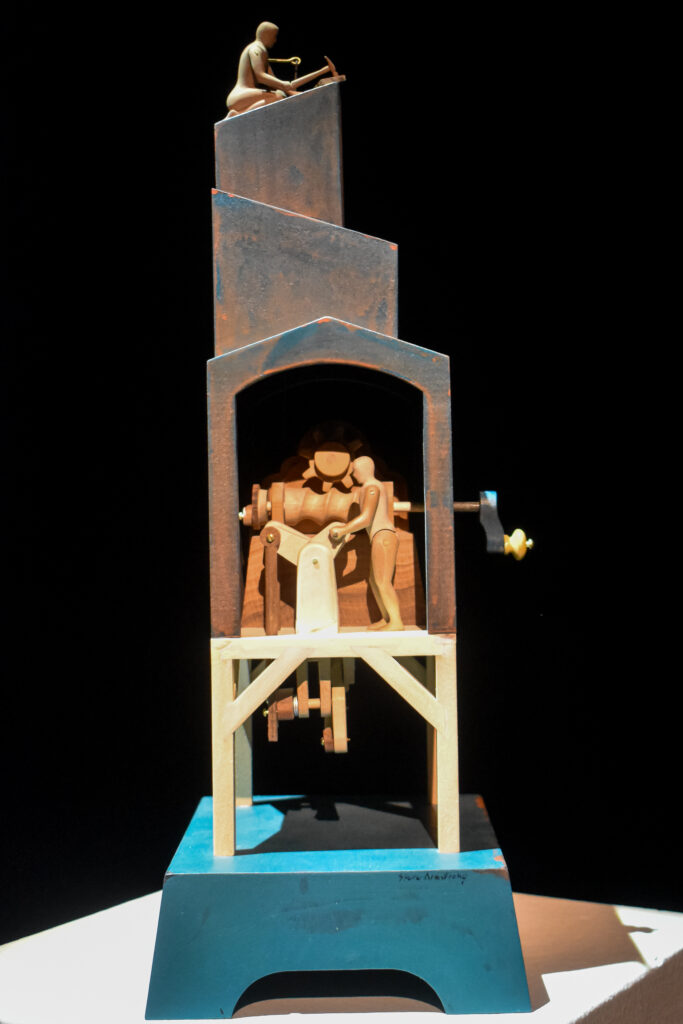
Lilliput, as readers of Gulliver’s Travels will recall, is a dangerous place. The novel’s hero finds himself bound head to foot by the tiny but all too capable, all too human beings who capture, fear, willfully misunderstand, and sometimes threaten to kill him. They decide not to do so only because the fumes from his rotting corpse might produce a pestilence – a pandemic, you might say – that could infect them all. Even after he ceases to be their prisoner, they give him all manner of grief, including convicting him of treason and sentencing him to be blinded. Poor Gulliver barely escapes their land still of sound mind and body, and looks back upon his time there as an absurd but harrowing trial.
If you look past the brighter wonderments of “Last Train to Lilliput,” you may pick up clues of another pestilence, another pandemic, this one far closer to home. Look hard, for example, at “Beast,” in which a man barely manages to stay upright on the back of a bounding, horned, antelope-like creature, and you may be startled to discover that the rider is wearing what appears to be a surgical facemask. What beast, in fact, is this?
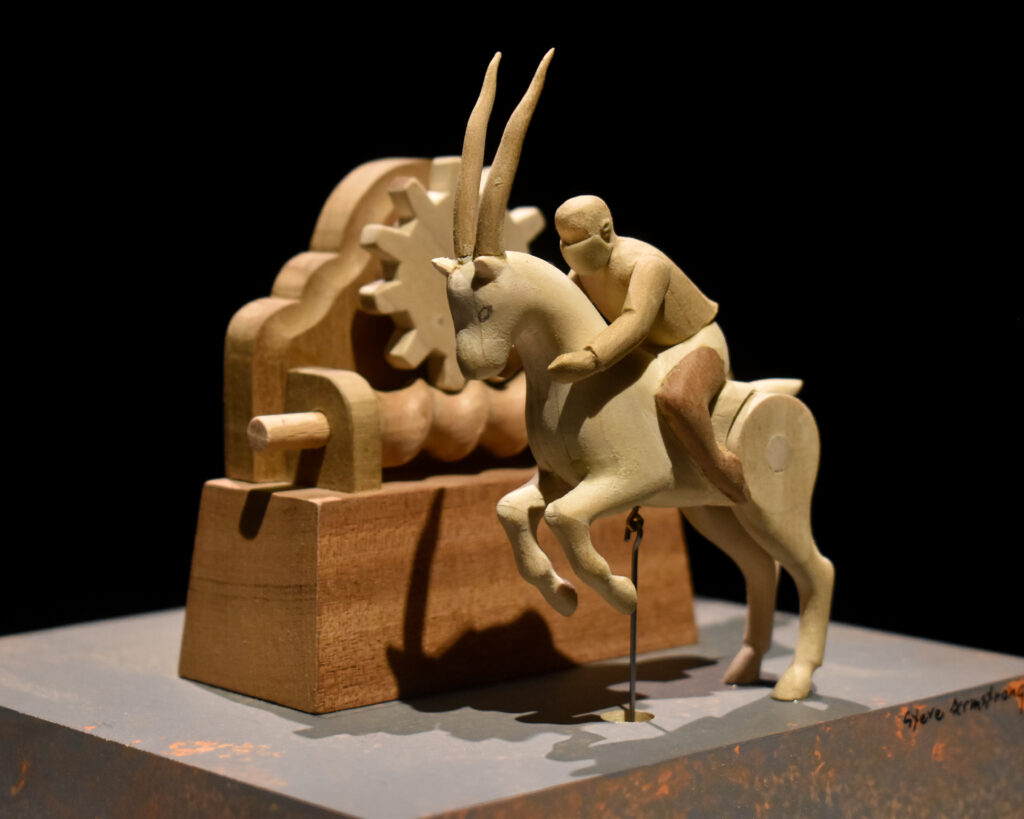
Then there’s the show’s centerpiece and its masterpiece: “Tenement,” a tour de force that Armstrong described to me as relating specifically to the coronavirus pandemic and the isolation it has forced on many of us, including the artist himself, these past two years. Inside its multilevel structure of rooms and other spaces, reminiscent of a dollhouse or an elaborate model of a stage set, “Tenement” shows us, well, us – sealed in our own compartments, lonely, doleful, slumping like mannequins. And here the piece’s movement does prove crucial. Turn the crank and a violinist plays; in an upper window, a dancer twirls; down below, a woman sweeps the floor with a rhythm that suggests that she hears the music and is fortified by it. Even apart, Armstrong is telling us – even in these awful, dark, harrowing days and nights – art can keep us going, as it has kept him going. The work continues.
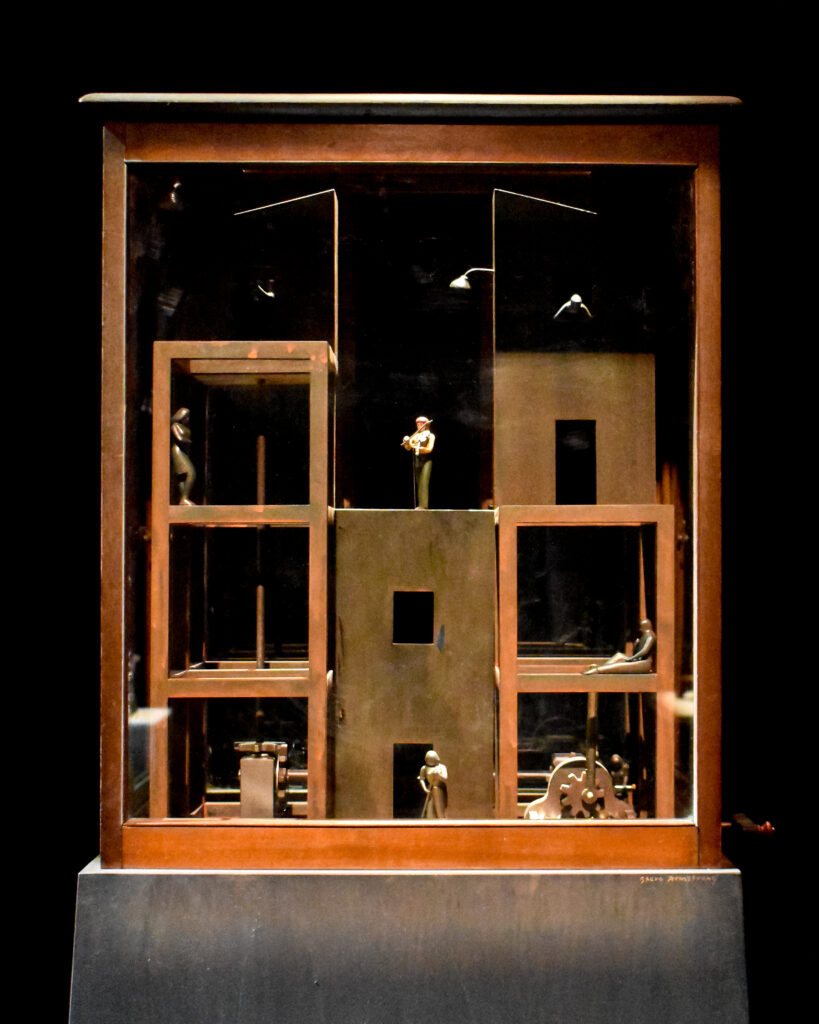
All photos and video courtesy of Kevin Nance.




